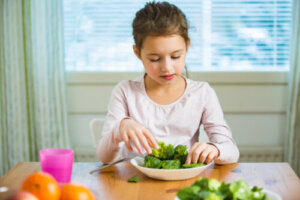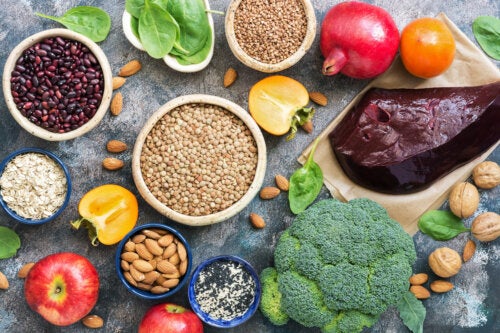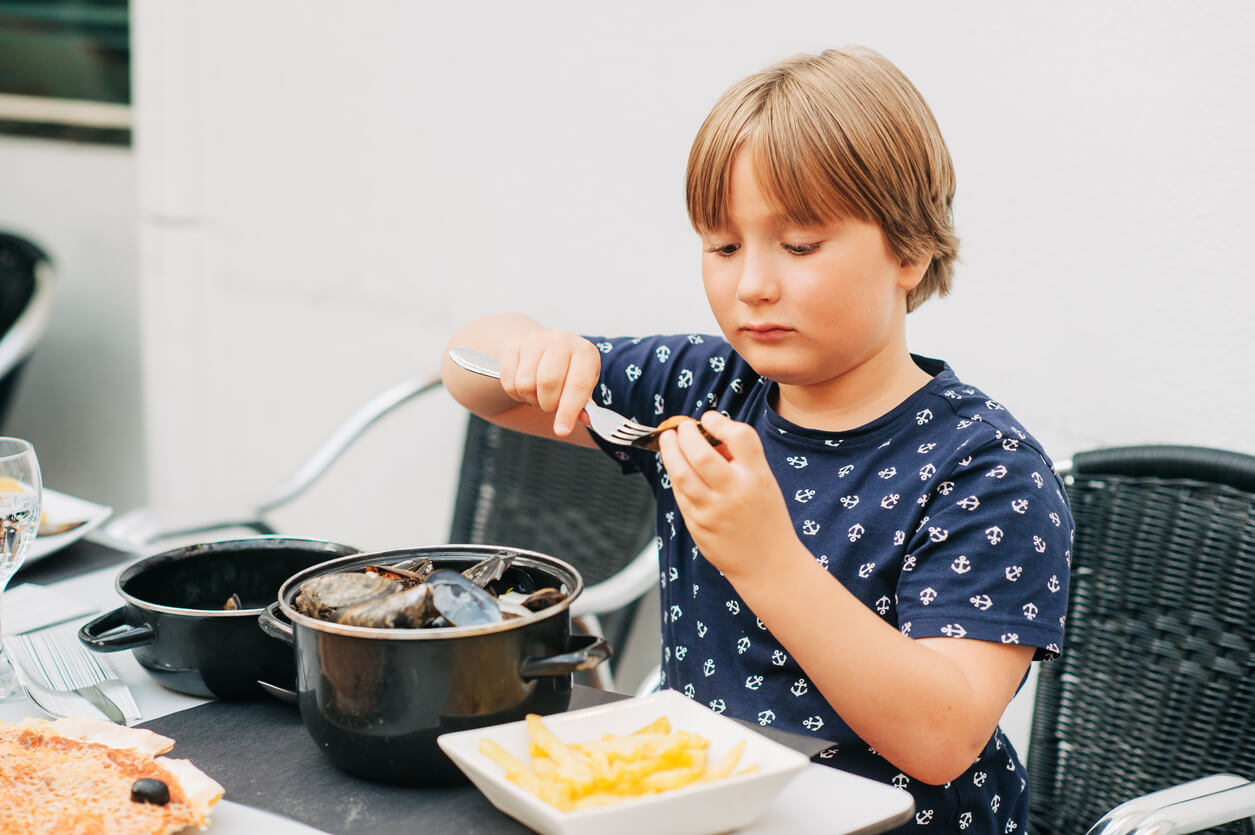4 Foods to Combat Childhood Anemia


Written and verified by the nutritionist Saúl Sánchez Arias
Infantile anemia is a disease that negatively conditions the supply of oxygen to the tissues through the blood. It’s caused by an iron deficiency and generates a situation of chronic tiredness and fatigue. However, there are a number of foods that help to combat childhood anemia when introduced into a varied diet.
The first thing to keep in mind is that it’s crucial to ensure an optimal supply of nutrients throughout the day. Otherwise, inefficiencies in the functioning of human physiology could be experienced in the medium term, leading to chronic diseases.
Foods to combat childhood anemia
Next, we’re going to show you what the main foods that help fight childhood anemia are. All of them are characterized by a significant presence of iron. This mineral will be decisive in order to solve the problem.
1. Legumes

Legumes have in their interior a great number of vitamins and minerals. However, they also contain fiber, which is a substance that can act as an anti-nutrient and reduce their absorption. For this reason, it’s important to cook them for several hours over low heat. This way, the fibers are softened and exert less effect.
It should be noted that nutrition experts advise the presence of legumes in the diet once or twice a week, as they provide many elements that are beneficial to health in the medium term.
2. Veal liver
Viscera stand out for their nutritional density. Of all of them, it’s important to make a special mention regarding liver. This food contains iron of the highest quality, a key element to prevent and combat childhood anemia. This is evidenced by a study published in the journal The Medical Clinics of North America. The inefficient supply of this nutrient is one of the most frequent causes of the disease.
In addition, the liver has a much lower microbiological risk than other common viscera, such as the intestines. Furthermore, the acceptance by children is also greater. In addition, it can be included in different culinary preparations that camouflage its organoleptic characteristics in case the little ones don’t like this food very much.
3. Spinach
Spinach contains iron of vegetable origin. The availability of this type of nutrient isn’t very high, although it’s significantly enhanced thanks to vitamin C, which it also contains. The intake of both nutrients together improves the absorption of the mineral, according to research published in the journal JAMA.
In fact, many iron supplements are administered with vitamin C to correct cases of anemia that have already developed. For this reason, these products are often recommended for athletes, who have increased nutritional needs due to exertion and impact.
4. Mussels

Some products from the sea can also be introduced into the diet in order to combat anemia. In particular, mollusks stand out for the presence of iron in their interior. In addition, they’re a source of minerals and proteins, so they help to ensure proper growth and development.
It’s important to cook them properly and make sure they’ve passed a series of quality criteria. Although there are usually no problems with these foods, they have a higher microbiological risk than most fish.
Introduce foods in the diet to combat childhood anemia
As you’ve seen, when the objective is to combat anemia, a large amount of foods with a high concentration of iron in them should be included in the diet. If this mineral is administered with a certain dose of vitamin C, even better. Thus, the availability of a nutrient that usually has a low absorption rate is enhanced.
Remember that by means of a varied diet, it’s less likely that the child will develop chronic and complex diseases. Therefore, it’s important to ensure a regular supply of essential nutrients. If there’s a suspicion of a deficit, it’s possible to consult a nutrition specialist to assess the need for supplementation with a specific product.
Infantile anemia is a disease that negatively conditions the supply of oxygen to the tissues through the blood. It’s caused by an iron deficiency and generates a situation of chronic tiredness and fatigue. However, there are a number of foods that help to combat childhood anemia when introduced into a varied diet.
The first thing to keep in mind is that it’s crucial to ensure an optimal supply of nutrients throughout the day. Otherwise, inefficiencies in the functioning of human physiology could be experienced in the medium term, leading to chronic diseases.
Foods to combat childhood anemia
Next, we’re going to show you what the main foods that help fight childhood anemia are. All of them are characterized by a significant presence of iron. This mineral will be decisive in order to solve the problem.
1. Legumes

Legumes have in their interior a great number of vitamins and minerals. However, they also contain fiber, which is a substance that can act as an anti-nutrient and reduce their absorption. For this reason, it’s important to cook them for several hours over low heat. This way, the fibers are softened and exert less effect.
It should be noted that nutrition experts advise the presence of legumes in the diet once or twice a week, as they provide many elements that are beneficial to health in the medium term.
2. Veal liver
Viscera stand out for their nutritional density. Of all of them, it’s important to make a special mention regarding liver. This food contains iron of the highest quality, a key element to prevent and combat childhood anemia. This is evidenced by a study published in the journal The Medical Clinics of North America. The inefficient supply of this nutrient is one of the most frequent causes of the disease.
In addition, the liver has a much lower microbiological risk than other common viscera, such as the intestines. Furthermore, the acceptance by children is also greater. In addition, it can be included in different culinary preparations that camouflage its organoleptic characteristics in case the little ones don’t like this food very much.
3. Spinach
Spinach contains iron of vegetable origin. The availability of this type of nutrient isn’t very high, although it’s significantly enhanced thanks to vitamin C, which it also contains. The intake of both nutrients together improves the absorption of the mineral, according to research published in the journal JAMA.
In fact, many iron supplements are administered with vitamin C to correct cases of anemia that have already developed. For this reason, these products are often recommended for athletes, who have increased nutritional needs due to exertion and impact.
4. Mussels

Some products from the sea can also be introduced into the diet in order to combat anemia. In particular, mollusks stand out for the presence of iron in their interior. In addition, they’re a source of minerals and proteins, so they help to ensure proper growth and development.
It’s important to cook them properly and make sure they’ve passed a series of quality criteria. Although there are usually no problems with these foods, they have a higher microbiological risk than most fish.
Introduce foods in the diet to combat childhood anemia
As you’ve seen, when the objective is to combat anemia, a large amount of foods with a high concentration of iron in them should be included in the diet. If this mineral is administered with a certain dose of vitamin C, even better. Thus, the availability of a nutrient that usually has a low absorption rate is enhanced.
Remember that by means of a varied diet, it’s less likely that the child will develop chronic and complex diseases. Therefore, it’s important to ensure a regular supply of essential nutrients. If there’s a suspicion of a deficit, it’s possible to consult a nutrition specialist to assess the need for supplementation with a specific product.
All cited sources were thoroughly reviewed by our team to ensure their quality, reliability, currency, and validity. The bibliography of this article was considered reliable and of academic or scientific accuracy.
- DeLoughery T. G. (2017). Iron Deficiency Anemia. The Medical clinics of North America, 101(2), 319–332. https://doi.org/10.1016/j.mcna.2016.09.004
- Li, N., Zhao, G., Wu, W., Zhang, M., Liu, W., Chen, Q., & Wang, X. (2020). The Efficacy and Safety of Vitamin C for Iron Supplementation in Adult Patients With Iron Deficiency Anemia: A Randomized Clinical Trial. JAMA network open, 3(11), e2023644. https://doi.org/10.1001/jamanetworkopen.2020.23644
This text is provided for informational purposes only and does not replace consultation with a professional. If in doubt, consult your specialist.








